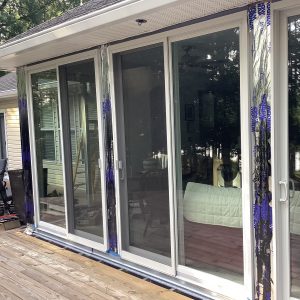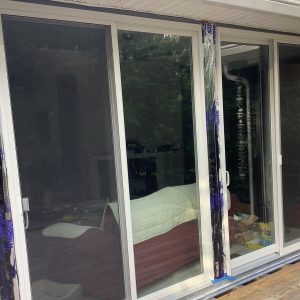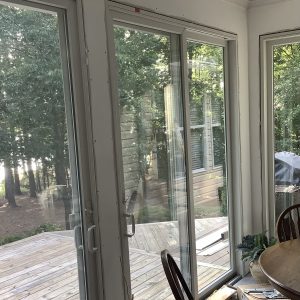Need to Flash & trim out a new 8’x6’ Andersen sliding door installation
I need HELP with my new Andersen Sliding Door installations. We installed five (5) new sliding doors & I want to install exterior flashing around the perimeter of each door. I also need to reinstall the vinyl siding that existed on the home. I understand i should NOT nail through the Andersen flanges, so now I’m stumped! I also understand i should NOT use ‘J-channel’ to surround the doors, yet i want to seal everything from the elements. I don’t know if I should use PVC trim boards around & in between 3 of the doors which are installed next to each other (8” apart) on the same rear wall, instead of the original vinyl siding. These are 8’ tall doors, so there is very little space between the top of the doors & the soffits, too. Please help!






















Replies
I wouldn't hesitate using 1x pvc to trim that entire installation. You can get 4x8 sheets if it cuts up better for you. The ripping at the top, and all other place for that matter shouldn't be tight fits. Leave room for some high quality caulking like PL door and window. The pvc will move with temperature change.
I can't believe a few small finish nails in the flange could harm those doors.
i agree with both of you 2sheps & Subrubanguy! I don’t understand the ‘NO nailing’ in the flanges, but Andersen has it printed right on the exterior side of the door flanges. See PIC taken during pre-install for fitting…….crazy! I want to do this right, so I have no water infiltration issues down the road, too. THANKS for the suggestions guys!!!
I believe the warning is there because those flanges are for sealing only, not structural support. The door has to be secured with screws through the side and head jambs.
It provides a good surface for the flashing tape to adhere to, nothing more.
Edit:
Nailing flanges usually have holes in them. In this particular case, the flange is not intended for nailing. See installation instructions (Step 11, pg 12): https://www.andersenwindows.com/-/media/aw/files/technical-docs/installation-guide/installationguide-0005310.pdf
But i could nail the flanges too, right?…..regardless of what I use to trim it out??
In some places, I have the flange lifting away from the wall a bit in spots (i think this is due to the silicone caulking in some locations that i put on the flange to seal it against the house), but the rest is sitting flat like it’s designed to do.
Should i stay away form replacing the vinyl siding & J-channel around the doors & stick with PVC boards then?
Then why are there flanges on those windows? The fastening of any product that trims the windows will have to puncture those flanges.
Vinyl J channel looks cheap and would take away from the loveliness of those doors. The alternative, custom formed, 4" wide aluminum J channel wouldn't leave any space between the doors for the siding.
I'd go with nice wide PVC trim and the advice of 2sheps. Rabbet the PVC where required to accept the re-installed vinyl siding. (Solid PVC between the doors.) Use PVC plugs to cover any fasteners. It will look great.
Suburbanguy & Hoffco76 and others. OK, it looks like solid PVC between the doors w/no siding install. On the ends, ie: outside corner & two ends meeting an adjoining wall @ 90 degrees, then i should use the vinyl siding w/outside 3” vinyl corner post to bring the two sides together??? That’s kinda what I’m thinking.
Not sure i could, should, or wanna run solid PVC right to the wall ends. Any thoughts?
Well, I'll only add that Andersen's nailing flanges are, guess what, NAILING Flanges. I've installed many dozens, maybe hundreds of them and never a single callback or problem related to the nailing flanges. Now, would I nail trim very close to the window jamb, not so much. Common sense will suffice.
What we do on our installs in this situation is mount the door or window, flashing tape, paper, insulation (if using)and we finish the look using a PVC molding that has a channel for the siding to slide into. The molding comes in varying widths-can be ripped down if needed- we usually miter it in and install with finish nails, not hitting the flange.
But i could nail the flanges too, right?…..regardless of what I use to trim it out??
In some places, I have the flange lifting away from the wall a bit in spots (i think this is due to the silicone caulking in some locations that i put on the flange to seal it against the house), but the rest is sitting flat like it’s designed to do.
It won't do any harm, as the flashing will cover the nail heads. I don't see any reason to put them in though. If the caulking is causing a bump, a nail is not going to get rid of it.
As long as the trim boards will sit flat against the wall, and the self adhering flashing can be installed smoothly, I'd just ignore the bump.
If the bump is large enough to interfere with the trim board, you can clean out the bump from behind the flange with a thin blade, or cut a back relief on the trim so it sits flat.
Make sure the flashing will sit smoothly on the flange, close enough to the frame that when you apply sealant to the outside frame/flange corner, it will cover the edge of the flashing as well.
Got it! Thanks so much. Think I’m gonna use the Versatex trim board product that I’ve been researching, too. Want this over & behind me! I take any too long on stuff sometimes.